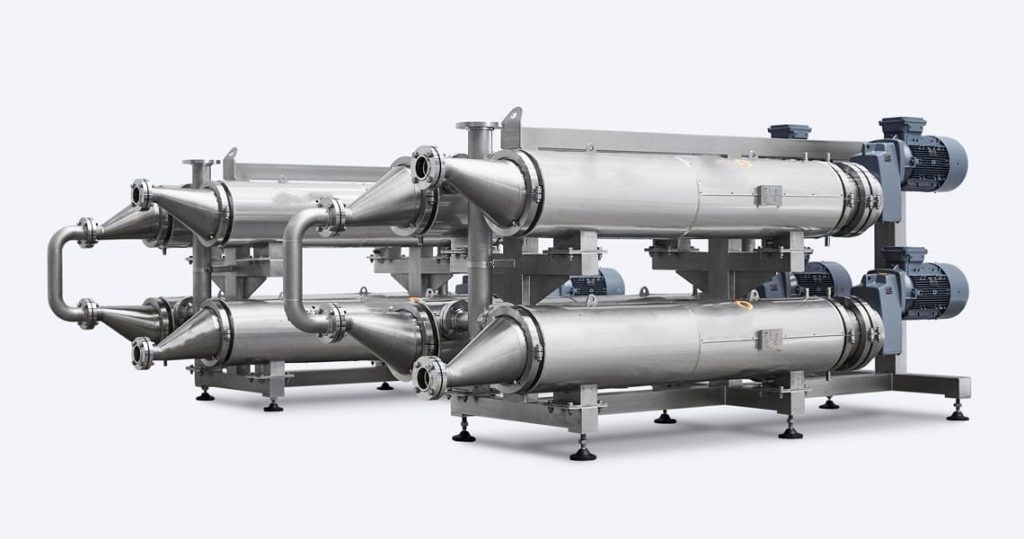Scraped Surface Heat Exchangers (SSHEs) are engineered for one key challenge—efficient heat transfer in viscous, sticky, or fouling-prone fluids where traditional exchangers fail. Unlike conventional designs, SSHEs incorporate rotating blades that continuously scrape the inner surface of the heat exchanger, preventing buildup and maintaining thermal performance. This unique mechanical action allows for precise temperature control, consistent product quality, and hygienic processing across a wide range of industries—from food and dairy to pharmaceuticals, cosmetics, chemicals, and advanced battery manufacturing. Whether dealing with crystallization, pasteurization, or high-viscosity mixtures, SSHEs offer a robust solution where thermal performance and cleanability are non-negotiable.
Unique Functional Highlights
Dual Function: Heat Transfer + Mixing
SSHEs don’t just exchange heat — the internal scraping blades often rotate, acting as mild agitators. This mixing prevents hotspots, promotes even temperature distribution, and helps maintain the desired rheological properties of shear-sensitive products like creams or sauces.
Dynamic Adaptability
In modern systems, scraper rotation speed and direction can be varied based on product behavior, allowing customized processing. Reverse scraping action can reduce product shear stress — crucial for emulsions or protein-based fluids.
Controlled Crystal Growth
In crystallization processes (like making ice cream or margarine), SSHEs allow precise temperature control and mechanical agitation to influence the size, shape, and distribution of crystals — essential for texture, mouthfeel, and stability in food and pharmaceutical products.
In-line Cleaning Efficiency
Unlike other exchangers that require dismantling for cleaning, SSHEs are often CIP (Clean-In-Place) capable, thanks to their scraping action preventing hard fouling. This makes them ideal for industries with strict hygiene requirements like dairy, biotech, and cosmetics.
Niche Applications Beyond Food
- Cosmetic Creams & Gels
The uniform shear and temperature control make SSHEs perfect for emulsified creams and viscous gels, where smoothness and thermal stability are vital. - Battery Slurries & Gels
In battery manufacturing, SSHEs are used to process high-viscosity slurries like lithium-based gels, which require precise thermal control and homogeneity. - Adhesives & Sealants
In the chemical industry, SSHEs handle thermally reactive or curing adhesives while preventing localized overheating or premature curing. - Biotech Fermentation Residue Recovery
Viscous fermentation residues with high bio-load can be concentrated using SSHEs without fouling, recovering proteins, enzymes, or residual active compounds.
Innovations in Modern SSHE Design
- Magnetic Drive Scrapers
Some high-end SSHEs now use magnetically driven rotors, eliminating shaft seals and reducing contamination risks — a game-changer for aseptic or sterile processing. - Smart Sensor Integration
Advanced systems integrate real-time viscosity and temperature sensors that adjust scraper speed and coolant flow automatically — a key feature in process automation. - Hybrid Cooling Techniques
Dual-fluid jackets or phase-change cooling systems are being tested in SSHEs to improve energy efficiency and handle ultra-high-viscosity or heat-sensitive products. - Modular Scraper Blades
Some SSHEs now offer interchangeable blades (polymer, metal, or Teflon-coated) based on product texture, cleaning frequency, and regulatory needs.
SSHE vs Traditional Heat Exchangers
While traditional exchangers (like shell-and-tube or plate types) perform well for low-viscosity or clean fluids, they rapidly lose efficiency with sticky, solidifying, or fouling materials. SSHEs maintain heat transfer even as the product changes state, such as going from liquid to semi-solid — a feature unmatched by standard exchangers.
Common Myths Debunked
- “SSHEs are only for food”: False. They are widely used in chemical, pharmaceutical, personal care, and energy sectors.
- “They’re too expensive”: While upfront costs may be higher, their low maintenance, higher uptime, and reduced cleaning cycles make them more cost-effective in high-fouling applications.
- “They damage delicate products”: Not if designed right. With low-shear blade designs, SSHEs can handle even foam-sensitive or shear-sensitive fluids.
Scraped Surface Heat Exchangers are far more than niche food processing equipment — they are multi-industry thermal solutions that combine the power of mechanical agitation with controlled heat transfer. From ice cream to industrial adhesives, their versatility, hygiene capability, and resistance to fouling make them indispensable in modern thermal engineering.
As industries move toward smart manufacturing, energy efficiency, and product quality, SSHEs are evolving into high-precision, sensor-integrated tools that go beyond traditional heat exchangers in both performance and adaptability.
